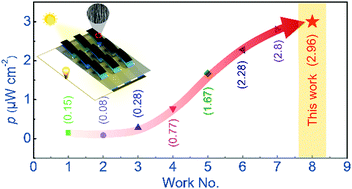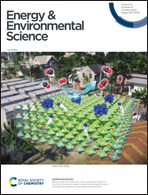Computation-guided design of high-performance flexible thermoelectric modules for sunlight-to-electricity conversion†
Abstract
Due to the outstanding mechanical endurance and easy scale-up fabrication, printed poly(3,4-ethylenedioxithiophene):poly(styrenesulfonate) (PEDOT:PSS) films are a promising thermoelectric material. However, their low thermoelectric performance, unreasonable device design and insufficient temperature gradient have significantly hindered the development of flexible PEDOT:PSS-based thermoelectric devices for their practical applications. To overcome these challenges, here we propose a novel method combining ethylene glycol pre-treatment and H2SO4 post-treatment plus tetrakis(dimethylamino)ethylene post-treatment in sequence to engineer printed flexible PEDOT:PSS films. The ethylene glycol pre-treatment strengthens the selective removal of excess non-ionized PSS to create a clear path for the further H2SO4 post-treatment, and in turn induces a structural conformation transition of the conjugated carbon chains in PEDOT:PSS films. The final tetrakis(dimethylamino)ethylene post-treatment induces a high power factor of 224 μW m−1 K−2 at room temperature by tuning the oxidation level of the fabricated PEDOT:PSS films. More importantly, we employ thermodynamic numerical analysis to computationally design and assemble a flexible module using the optimized PEDOT:PSS films. Such a module yields a record-high power output density of 3 μW cm−2 at a temperature gradient of 44.5 K induced by harvesting sunlight, and has no notable performance change after mechanical (1000 bending cycles), air stability (30-day air exposure) and thermal stability (20 heating and cooling cycles) tests. This study indicates that our computation-guided module can be widely applied to supply power for micro-watt electronics by virtue of the high-efficiency sunlight-to-electricity conversion.



 Please wait while we load your content...
Please wait while we load your content...